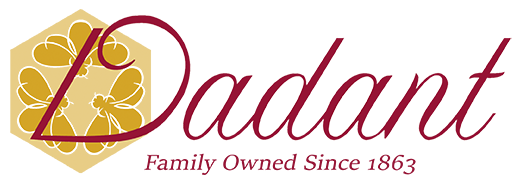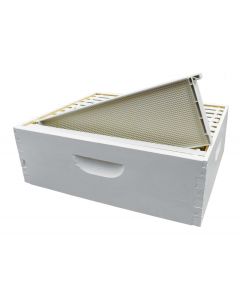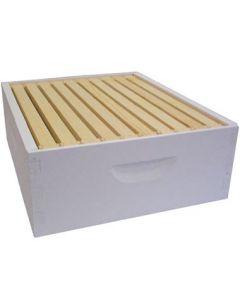10-Frame
What to Know About 10-Frame Hives
10-frame hives have been the industry standard of American beekeeping for over a century, and they are the most commonly used hive in North America. With enough space for honey and brood as well as better mobility than hives created before its invention, standard 10-frame hives and hive kits are a great choice especially if it’s your first time raising a colony.
History and Characteristics of Langstroth Hives
Before Langstroth beehives were developed, beekeepers had originally used horizontal hives to raise bees. When beekeeping moved into central Europe, beekeepers replaced horizontal hives with upright hives made from hollow logs.
Because these were difficult to move, skep hives were created and used for a millennium. However, it was much harder to harvest honey and comb from skep hives because comb was often damaged and bee colonies were more likely to die.
Reverend Lorenzo Langstroth designed the classic Langstroth beehive in the 1850s, and it quickly became the cornerstone of modern beekeeping. Langstroth developed his hive from the writings of Francis Huber, who created the Huber leaf hive, and writings on several bar hives by Edward Bevan, who created the vertical Bevan bar hive.
The Huber hive had enclosed frames where bees produced their comb, while the Bevan bar hive used wooden bars that were fitted into rabbets, and both characteristics were included in his own design.
Langstroth found that bees would seal the top of the Bevan hive to the top bars of frames with propolis. He found that creating a 3/8" gap between the top cover and bars prevented bees from propolizing the hive.
Putting the same “bee gap” all around the frames made it easy to remove them from the hive without having to cut them away from the hive walls. This created a true moveable-frame hive.
Since the first Langstroth hive, the hive has improved to create what we see today. It is still the most commonly used hive in North America.
10-frame hives are the most commonly used Langstroth hive, but 8-frame hives have increased in popularity over the past few decades.
10-Frame Hive Characteristics
The basic Langstroth hive is composed of seven basic parts: hive stand, bottom board, hive body (also known as the brood chamber, brood nest, brood box, and deep box/deep super), queen excluder (optional), honey super (usually a shallow box), inner cover and telescoping outer cover.
Inside the hive body and honey super are 10 frames, which bees use to create comb for raising brood and producing honey. Be aware that bees may instinctively move up the hive instead of using all available frames.
Langstroth beehives are available in wood and plastic. Dadant offers 10-frame wood hives made of high quality Ponderosa pine and BeeMax hives made of polystyrene.
Foundationless frames are also available for those who prefer natural beekeeping practices. These types of frames allow bees to create their own comb instead of using foundation comb.
Because 10-frame hives are the most commonly used design in the United States, there are tons of tools and accessories compatible for these hives.
Comparing 10-Frame Hives to Other Hive Options
8-Frame Hives
8-frame hives are identical to 10-frame hives, as they have the same shape and configuration. The main differences are that these hives are narrower because they only hold eight frames. This results in a hive that may ultimately be lighter and easier to move.
The biggest advantage of this type of hive is that the narrower shape takes bees’ natural instincts into account. Honey bees’ favorite habitat is a hollow tree trunk, which allows them to move up quickly and stay in a warm cluster during winter.
Because of this, bees will be more likely to use up all eight frames before moving up to the next box and remain warm during winter.
8-frame hives are smaller and lighter than 10-frame beehives, thus making them easier to move during regular inspections and honey harvesting.
Because the bees may move up faster, however, you may need to purchase more honey supers to keep the colony comfortable. These hives may become a high stack, which makes them more likely to tip over, especially in moderate to severe weather or high wind conditions.
These hives are also a recent development, having been created only a few decades earlier, which makes finding compatible accessories much more difficult. Fortunately, Dadant offers many tools and accessories for this type of hive.
Top Bar Hives
The biggest difference between a Langstroth and a top bar hive is that a Langstroth has a vertical shape, while a top bar has a horizontal shape.
While Langstroth 10-frame hives are considered the North American industry standard, top bar hives have been used the most around the world for centuries, and they can be dated back to Ancient Egypt. Today, top bar hives are most commonly used by beekeepers who use natural beekeeping practices.
Rather than following a foundation or creating a comb on a frame, bees instead hang comb from bars set at the top of the hive.
Frequent inspections are important for top bar hives to make sure bees have adequate space and enough empty bars to produce comb and honey. With a divider board, you control the colony’s space, which must be widened as the colony grows and narrowed during winter after the final honey harvest so bees have less space to heat during winter months.
The main advantages of top bar hives are that combs are easy to remove, frames are lighter, neither crouching nor bending are required during inspections, honey harvest is easy, inspections are quick due to a full length observation window, and bees are more docile during inspections. You also do not need to purchase honey harvesting equipment besides a hive tool to harvest honey.
The biggest disadvantage is that top bar hives are not standardized. It will be much more difficult to find parts that are compatible with a top bar hive. Combs are also much more fragile without a foundation, and cross-combing across bars may occur, which can be challenging for a new beekeeper.
There are no expansion options, either, as it is self-contained. This also means that honey harvest will be lower compared to a Langstroth hive.
The Bottom Line
Ultimately, the hive you choose depends on your own personal preferences and experiences with beekeeping. If you’re new to beekeeping, finding a beekeeping mentor in your local area will be the most helpful.
If you’re looking to learn more about beekeeping, consider looking at our selection of books that beekeepers of all levels can learn from.


































